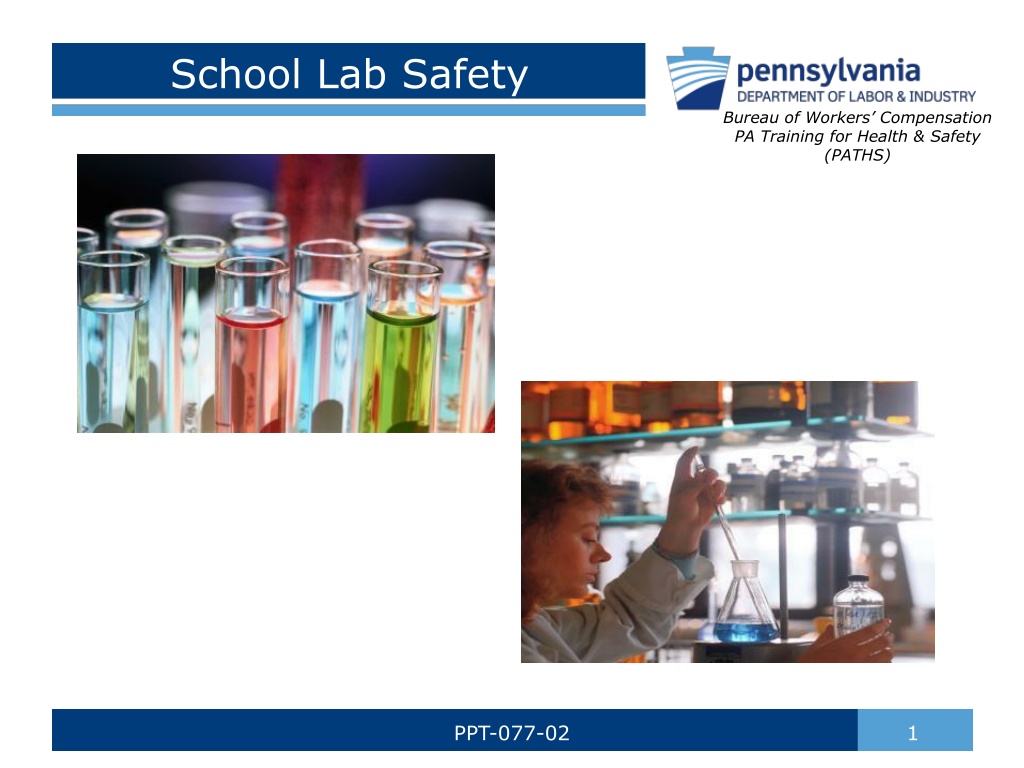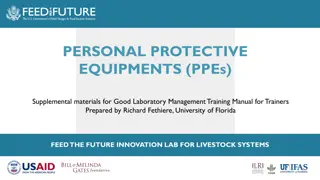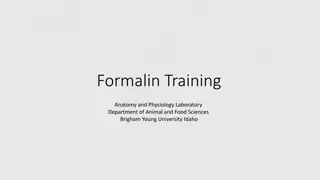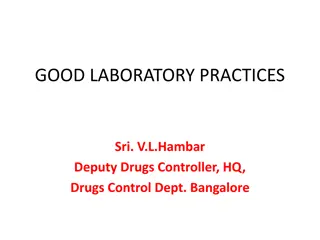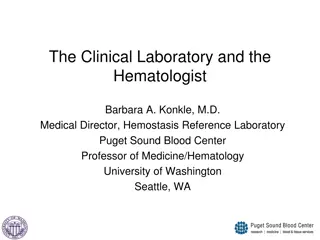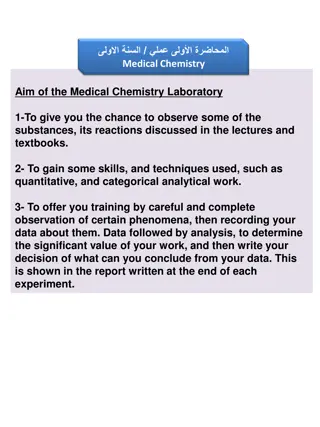School Laboratory Safety Training Overview
Explore essential topics in school lab safety training, including regulations, acronyms, roles and responsibilities, chemical handling, waste disposal, emergency procedures, and more. Learn about the importance of safety programs in schools and the crucial role of teachers in creating a safe learning environment for students.
Download Presentation

Please find below an Image/Link to download the presentation.
The content on the website is provided AS IS for your information and personal use only. It may not be sold, licensed, or shared on other websites without obtaining consent from the author. Download presentation by click this link. If you encounter any issues during the download, it is possible that the publisher has removed the file from their server.
E N D
Presentation Transcript
School Lab Safety Bureau of Workers Compensation PA Training for Health & Safety (PATHS) PPT-077-02 1
What Well Talk About Acronyms & Regulations Roles & Responsibilities General Lab Safety Chemical Labeling & Storage Spill Response Waste Disposal Compressed Gas Cylinders Ventilation Emergency Eyewash/Shower Stations First Aid PPT-077-02 2
Acronyms OSHA Occupational Safety & Health Administration EPA Environmental Protection Agency PADEP Pennsylvania Department of Environmental Protection NIOSH National Institute of Occupational Safety & Health CDC Centers for Disease Control & Prevention NSC National Safety Council PPT-077-02 3
Possible Lab Regulations Occupational Exposures to Hazardous Chemicals in Laboratories OSHA Lab Standard (29CFR1910.1450) HAZWOPER (Chemical Spills) Hazardous Waste Operations Standard (29CFR1910.120) Bloodborne Pathogens (29CFR1910.1030) PPT-077-02 4
Possible Lab Regulations Noise Exposure Standard (1910.95) Personal Protection Equip Standard (1910.132) Respiratory Protection Standard (1910.134) Lockout/Tagout Standard (1910.147 & 333) Toxic & Hazardous Substances (1910.1000) Hazard Communication Standard (1910.1200) PPT-077-02 5
Globally Harmonized System PPT-077-02 6
School System Administrators Support for laboratory safety programs is the responsibility of school system administrators. School system administrators should appreciate the need for establishing safety and health instruction in science curriculum. Should operate their schools in as safe a manner as possible. PPT-077-02 7
Teachers Play the most important role in ensuring a safe and healthful learning environment for students. Ideal time to impress upon students the need for caution and preparation: before and during work with chemicals in science laboratories. PPT-077-02 8
Teachers Role Teachers have an obligation to: Instruct students in basic safety practices required in science laboratories. Instruct students in basic principles of health hazards found in most school science laboratories. Instructors must also: Provide safety information and training for every stage of experiment planning. Be there to observe, supervise, instruct, and correct during the experimentation. PPT-077-02 9
Teachers Responsibility Teachers and teacher s-aides should lead by example: Wear personal protective equipment (PPE). Follow and enforce safety rules, procedures, and practices. Demonstrate safety behavior and promote a culture of safety. Be proactive in every aspect of laboratory safety, making safety a priority. PPT-077-02 10
Students Develop attitudes towards safety and acquire habits of assessing hazards/risks when they are young. Come from diverse backgrounds and have various levels of preparation. Most have no previous hands on training in handling chemicals or equipment. Others may come well prepared to assume personal responsibility for risk assessment and safety planning. PPT-077-02 11
General Safety Do not wear loose/baggy clothing or dangling jewelry. Make sure long hair is tied back behind the ears. Never attempt to catch a falling object. Never leave experiments while in progress. Never fill a pipette using mouth suction. Do not leave lit Bunsen burners unattended. PPT-077-02 12
General Safety Turn off all heating apparatus, gas valves, and water faucets when not is use. Do not remove any equipment or chemicals from the laboratory. Coats, bags, and other personal items should not be stored on bench tops or in aisles. Do not eat, drink, or apply cosmetics within the laboratory. Wash hands after handling chemicals. Keep floors clear of all objects. PPT-077-02 13
General Safety Keep your hands away from your face, eyes, mouth, and body while using chemicals. Never use laboratory glassware for eating purposes. Wash hands after removing gloves and before leaving the lab. Remove protective equipment before leaving the lab. PPT-077-02 14
General Safety-Housekeeping Keep work areas neat and free of any unnecessary objects. Thoroughly clean laboratory work spaces at the end of each session. Do not block sink drains with debris. Never block access to exits or emergency equipment. Inspect all equipment for damage (e.g. cracks, defects, etc.) prior to use. Never pour chemical waste into trash cans. PPT-077-02 15
General Safety-Glassware Use caution when inserting/removing glass tubing from rubber stoppers. Protect your hands with towels or gloves when inserting/removing glass tubing. Chipped, cracked, or scratched glassware should never be used. Broken glassware must be placed in a box or hard plastic container with a plastic liner and appropriate signage. Always use glass drying racks to support glassware when drying. PPT-077-02 16
Personal Protective Equipment Always wear appropriate eye protection in the lab (e.g. chemical splash goggles). Wear chemical resistant gloves when handling hazardous chemicals and disposable gloves when handling other chemicals. Wear a full-length, long-sleeved lab coat or chemical resistant apron. Wear shoes that adequately cover the whole foot (low-heeled shoes with non-slip soles are preferred). PPT-077-02 17
Personal Protective Equipment Do not wear sandals, open-toed shoes, open- backed shoes or high-heels. Avoid wearing short dresses/skirts, shirts that expose the torso, or shorts. PPT-077-02 18
PPE: Eye Protection Use chemical splash goggles with indirect vents and meeting ANSI impact standard Z87.1 when working with hazardous liquids or solids. Use safety glasses with side shields and meeting ANSI impact standard Z87.1 when working with solids or projectiles. PPT-077-02 19
PPE: Gloves Use the proper glove when handling chemicals. Three materials that are very resistant to chemicals: neoprene, butyl, or nitrile. Disposable gloves may be acceptable for certain chemicals check the SDS and/or manufacturers specifications. PPT-077-02 20
Chemical Handling Check the chemical label to verify it is the correct substance before using. Always use a spatula or scoopula to remove a solid reagent from a container. Do not touch chemicals with bare hands. Never use a metal spatula when working with peroxides. Hold containers away from the body when transferring a chemical or solution from one container to another. PPT-077-02 21
Chemical Handling Use a hot water bath to heat flammable liquids, never use a flame. Add concentrated acid to water slowly; never add water to a concentrated acid. Weigh out or remove only the amount of chemical you will need; do not return excess to container, dispose of properly. Never touch, taste, or smell any reagents. Never place the container directly under your nose to inhale vapors. PPT-077-02 22
Chemical Handling Never mix or use chemicals not required in the lab exercise. When transporting chemicals: place the container in a secondary container or bucket (plastic, rubber, metal) designed to be carried and large enough to hold entire contents. Never handle bottles that are wet/too heavy. Use equipment in the way it was designed. PPT-077-02 23
Chemical Labeling No unlabeled substance should be present in the laboratory at any time! Labeling Basics: Use labels with good adhesive. Use a permanent marker (waterproof and fade resistant) or laser (not inkjet) printer. Print clearly and visibly. Replace damaged, faded or semi-attached labels. PPT-077-02 24
Chemical Labeling Commercially Packaged Chemicals Verify that the label contains the following information: Chemical name (as it appears on the SDS) Name of chemical manufacturer Necessary handling and hazard information Add: Date received Date first opened Expiration or use by date (if one is not present) PPT-077-02 25
Chemical Labeling Secondary Containers and Prepared Solutions Label all containers used for storage with the following: o Chemical name (as it appears on the SDS) o Name of the chemical manufacturer or person who prepared the solution o Necessary handling and hazard information o Concentration or purity o Date prepared o Expiration or use by date PPT-077-02 26
Chemical Labeling Containers in Immediate Use These chemicals are to be used within a work shift or laboratory session. Label all containers in immediate use with the following: o Chemical name (as it appears on the SDS) o Necessary handling and hazard information PPT-077-02 27
Chemical Labeling Peroxide-forming chemicals must be labeled with: Date received Date first opened Date to be disposed of PPT-077-02 28
Label Information-GHS Chemical manufacturers and importers must provide a label that includes: Harmonized signal word (Danger; Warning) Pictogram Hazard statement for each hazard class and category Precautionary statements must also be provided as well as product identifier and supplier information PPT-077-02 29
Pictograms - GHS Different symbol on white background with red square frame set on point Eight pictograms are required by OSHA The ninth one dealing with the environment is not within OSHA s jurisdiction PPT-077-02 30
Labels - GHS Information required on a GHS label: 1-Product identifier 2-Pictograms 3-Signal word 4-Hazard statement 5-Precautionary statement 6-Supplier information PPT-077-02 31
Chemical Waste All containers used for chemical waste should be labeled with: WASTE or HAZARDOUS WASTE Chemical name (as it appears on the SDS) Accumulation start date Hazard(s) associated with the chemical waste PPT-077-02 32
Chemical Waste Examples of Compliant Hazardous Waste Labels PPT-077-02 33
General Rules: Chemical Storage Criteria for Storage Area Store chemicals inside a closeable cabinet or on a sturdy shelf. Shelf should have a front-edge lip to prevent accidents and chemical spills (recommended - inch high). Shelving should be secured to wall or floor. Ensure that all storage areas have doors with locks. Keep chemical storage areas off limits to all students. Ventilate storage areas adequately. PPT-077-02 34
Chemical Storage What s in the coffee can? No lip on shelves Chemicals compatible? Any issues here? PPT-077-02 35
General Rules: Chemical Storage Locked Door Appropriate Signage PPT-077-02 36
General Rules: Chemical Storage Organization Organize chemicals first by COMPATIBILITY not alphabetic succession. Store alphabetically within compatible groups. PPT-077-02 37
General Rules: Chemical Storage Chemical Segregation Store acids in a dedicated acid cabinet. Nitric acid should be stored alone unless cabinet provides a separate compartment for nitric acid storage. Store highly toxic chemicals in a dedicated, lockable poison cabinet that has been labeled with a highly visible sign. PPT-077-02 38
General Rules: Chemical Storage ACID STORAGE CABINET What is causing this corrosion? Any safety concerns? PPT-077-02 39
General Rules: Chemical Storage Chemical Segregation Store volatile and odoriferous chemicals in a ventilated cabinet. Store flammables in an approved flammable liquid storage cabinet. Store water sensitive chemicals in a water-tight cabinet in a cool and dry location segregated from all other chemicals in the laboratory. PPT-077-02 40
General Rules: Chemical Storage Storage Don ts Do not place heavy materials, liquid chemicals, and large containers on high shelves. Do not store chemicals on tops of cabinets. Do not store chemicals on the floor, even temporarily. Do not store items on bench tops, in laboratory chemical hoods or under sinks. Not safe! PPT-077-02 41
General Rules: Chemical Storage Storage Don ts Do not store chemicals on shelves above eye level. Do not store chemicals with food and drink. Do not store chemicals in personal staff refrigerators, even temporarily. Do not expose stored chemicals to direct heat or sunlight, or highly variable temperatures. PPT-077-02 42
General Rules: Chemical Storage Proper Use of Chemical Storage Containers Never use food containers for chemical storage. Make sure all containers are properly closed. After each use, carefully wipe down the outside of the container with a paper towel before returning it to the storage area. Properly dispose of the paper towel after use. PPT-077-02 43
Safety Data Sheet Contains information regarding the proper procedures for handling, storing, and disposing of chemical substances. SDS accompanies all chemicals or kits that contain chemicals. SDS s can be obtained from related web sites (e.g. hazard.com) and manufacturers. PPT-077-02 44
Safety Data Sheet Save all SDS s and store in a designated file or binder. Use a system that is organized and easy to understand. Place SDS collection in a central, easily accessible location known to all workers and emergency personnel. Typically the information is listed in a standardized format. PPT-077-02 45
Safety Data Sheet Categories Section 1: Identification Section 2: Hazard identification Section 3: Ingredients Section 4: First-aid measures Section 5: Fire fighting measure Section 6: Accidental release measures Section 7: Handling and storage PPT-077-02 46
Safety Data Sheet Categories Section 8: Exposure controls and personal protection Section 9: Physical and chemical properties Section 10: Stability and reactivity Section 11: Toxicological information Section 12: Ecological information* Section 13: Disposal considerations* Section 14: Transport information* Section 15: Regulatory information* Section 16: Other information * OSHA indicated that since other agencies regulate sections 12-15, OSHA will not be enforcing them PPT-077-02 47
Spill Response A chemical spill cart should be available to handle small spills in the laboratory Large spills and leaks require: Evacuation Contact local FD immediately (911) Emergency numbers: posted in each laboratory. Direct means of communications with front office by phone or intercom PPT-077-02 48
Spill Kit Should include: Spill control pillows/pads Neutralizing agents for acid spills Neutralizing agents for alkali spills Pick up equipment: brush, broom, pail, dust pan Personal protective equipment (PPE) Inert absorbents such as sand or kitty litter PPT-077-02 49
Spill Clean-up Use appropriate personal protective equipment: - Gloves - Apron - Chemical splash goggles - Closed-toe foot protection Clean up small spills with guidance of the appropriate SDS and/or procedures in place within your system. PPT-077-02 50
